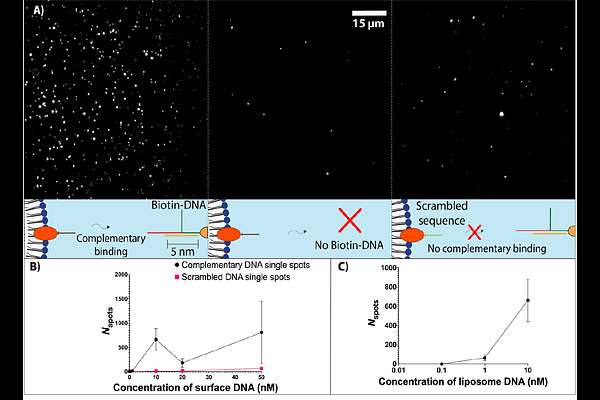The effect of PEGylation on surface tethering of liposomes via DNA nanotechnology.

The effect of PEGylation on surface tethering of liposomes via DNA nanotechnology.
Gaston, J.; Meepat, S.; Islam, M. S.; Daljit Singh, J. K.; Booth, M. J.; Wickham, S. F. J.; Baker, M. A.
AbstractPolyethylene glycol (PEG) is widely used in liposome formulation due to its blocking properties and ability to prolong circulation in vivo, to create biomimetic liposomes and drug delivery devices. Similarly, membrane-embedded DNA nanotechnology is increasingly used to modulate cellular behaviour and communication. However, there is a gap in knowledge in how PEG-lipid formulations can be optimised for both liposome properties and control of selective DNA hybridisation. To address this, we systematically investigated the effect of liposome PEG content on DNA mediated tethering of liposomes to glass surfaces. We formulated liposomes of two different lipid compositions (DOPE/DOPC or DPhPC), with varying amounts of PEGylated lipid (0-50%). We measured the effect of increased PEG content on liposome size and polydispersity through dynamic light scattering (DLS). Small amounts of PEG (0-20%) introduced repulsive forces that reduced size, while large amounts of PEG (30-50%) increased polydispersity. PEG-liposomes were then decorated with cholesterol-DNA strands and labelled with either intercalating lipid dyes or fluorescently labelled lipids. Binding to surfaces via complementary DNA strands was quantified using total internal reflection fluorescence (TIRF) microscopy. We found that PEGylation of DNA-liposomes could either block or enhance surface binding, depending on the amount of PEG. DNA-liposomes with reduced surface binding included DPhPC/DiD with 10% or 20% PEG-lipid. In contrast, DNA-liposome surface binding increased for DOPE/DOPC/DiD with increasing PEG%. This study highlights that while PEG can act to stabilise liposome formulations, its ability to block specific DNA binding interactions on membranes is variable and dependent on membrane composition.